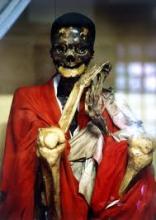A Buddhist monk already lives a life of austerity and self-denial. They are bound by a religious code that demands that they refuse their bodies all but the most essential needs in order to better commune with the divine. Priests seeking the immortality of ascendance through self-mummification, however, take that principle to an insane degree.
Monks pursuing this end would fast for three years, eating only a diet of nuts and seeds and pursuing a regimen of exercise that stripped their body fat from them. At the end of this three year period the monk would be quite healthy and with an incredibly high metabolism. The next three years the monk would eat only bark and roots and drink only a kind of poisonous tea from sap from a kind of tree used to lacquer bowls. This would cause the monk to vomit and evacuate often, losing bodily fluids and killing off parasites in their bodies that may cause their bodies to decompose. Finally, when the monk was near death, they would lock themselves in a stone tomb only big enough to accommodate their body. In those stone tomb would be an air tube and a bell. Every day the monk would sit within their tube in the lotus position, ringing the bell once to let the monastery above know that they were still alive. When the bell didn’t ring, those above would know that the monk was dead and they would seal the tomb. Years later the tombs would be opened and, if the self-mummification was successful, the monk would be raised to the status of Buddha, put on display, and worshipped as religious relics. These mummies, known as “sokushinbutsu”, still number 28 in Japan, though not all are publicly visible. Many monks, when their tombs were opened, were found to have rotted. Although they were respected for their discipline and endurance, but were not worshipped.
